PSY121 - Panic Disorder: Diagnosis, Treatment, and Research Trends
VerifiedAdded on 2023/05/30
|11
|1080
|406
Presentation
AI Summary
This presentation provides a comprehensive overview of panic disorder, addressing its diagnostic features, symptoms, prevalence rates, and typical course. It explores the genetic basis of the disorder and its comorbidity with other psychological conditions. Treatment options, including psychotherapy (cognitive behavioral therapy) and medications (SSRIs, SNRIs, and Benzodiazepines), are discussed. The presentation also highlights current research areas, such as MCTs, HCAR1s, and the role of exercise, and offers recommendations for future research, including studies on CBT interventions, psychodynamic psychotherapy, and potential long-term adverse effects of combined treatment approaches. Desklib offers a wealth of study resources, including past papers and solved assignments, to aid students in their academic pursuits.

Panic disorder
Paraphrase This Document
Need a fresh take? Get an instant paraphrase of this document with our AI Paraphraser
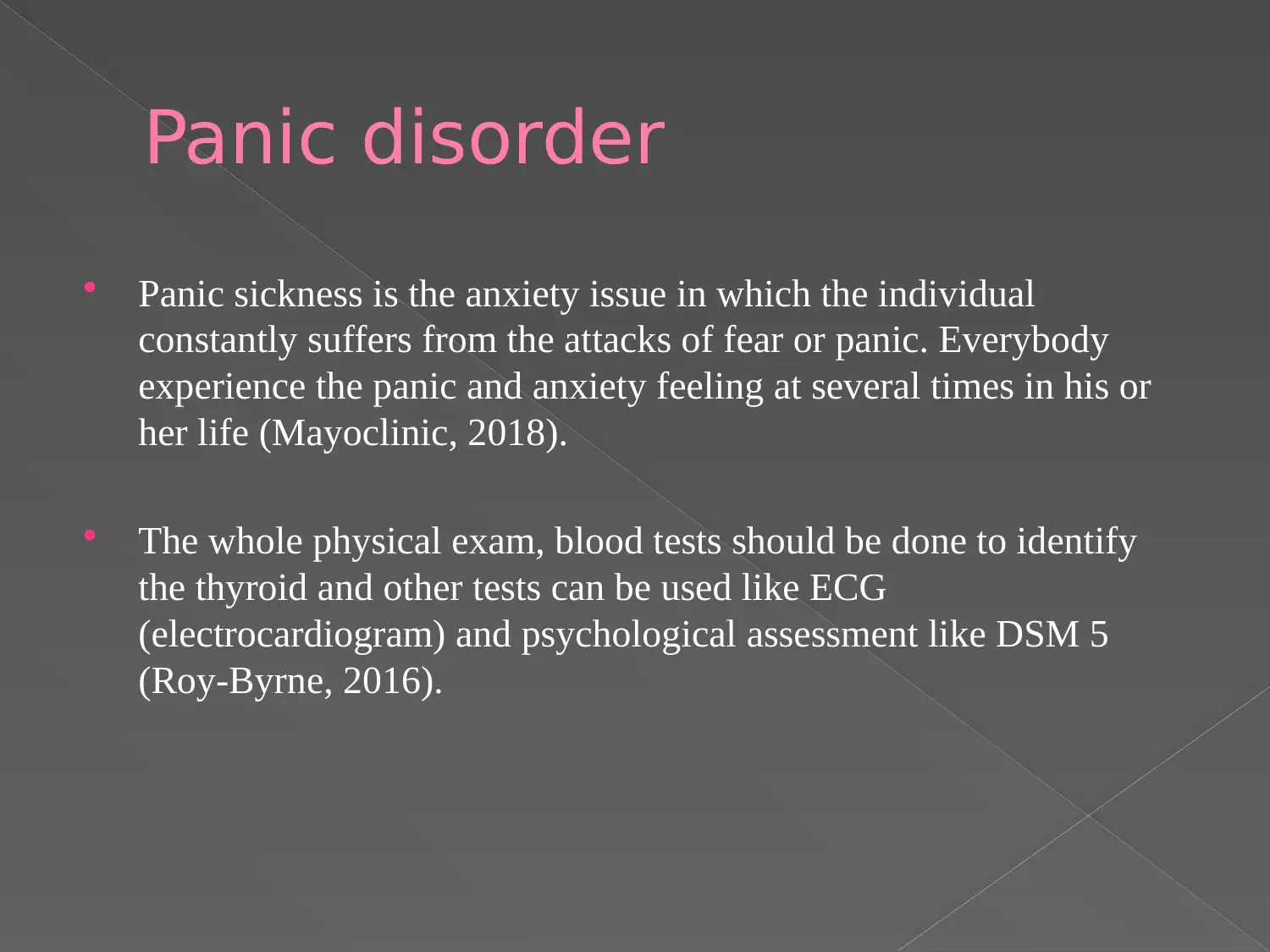
Panic disorder
Panic sickness is the anxiety issue in which the individual
constantly suffers from the attacks of fear or panic. Everybody
experience the panic and anxiety feeling at several times in his or
her life (Mayoclinic, 2018).
The whole physical exam, blood tests should be done to identify
the thyroid and other tests can be used like ECG
(electrocardiogram) and psychological assessment like DSM 5
(Roy-Byrne, 2016).
Panic sickness is the anxiety issue in which the individual
constantly suffers from the attacks of fear or panic. Everybody
experience the panic and anxiety feeling at several times in his or
her life (Mayoclinic, 2018).
The whole physical exam, blood tests should be done to identify
the thyroid and other tests can be used like ECG
(electrocardiogram) and psychological assessment like DSM 5
(Roy-Byrne, 2016).
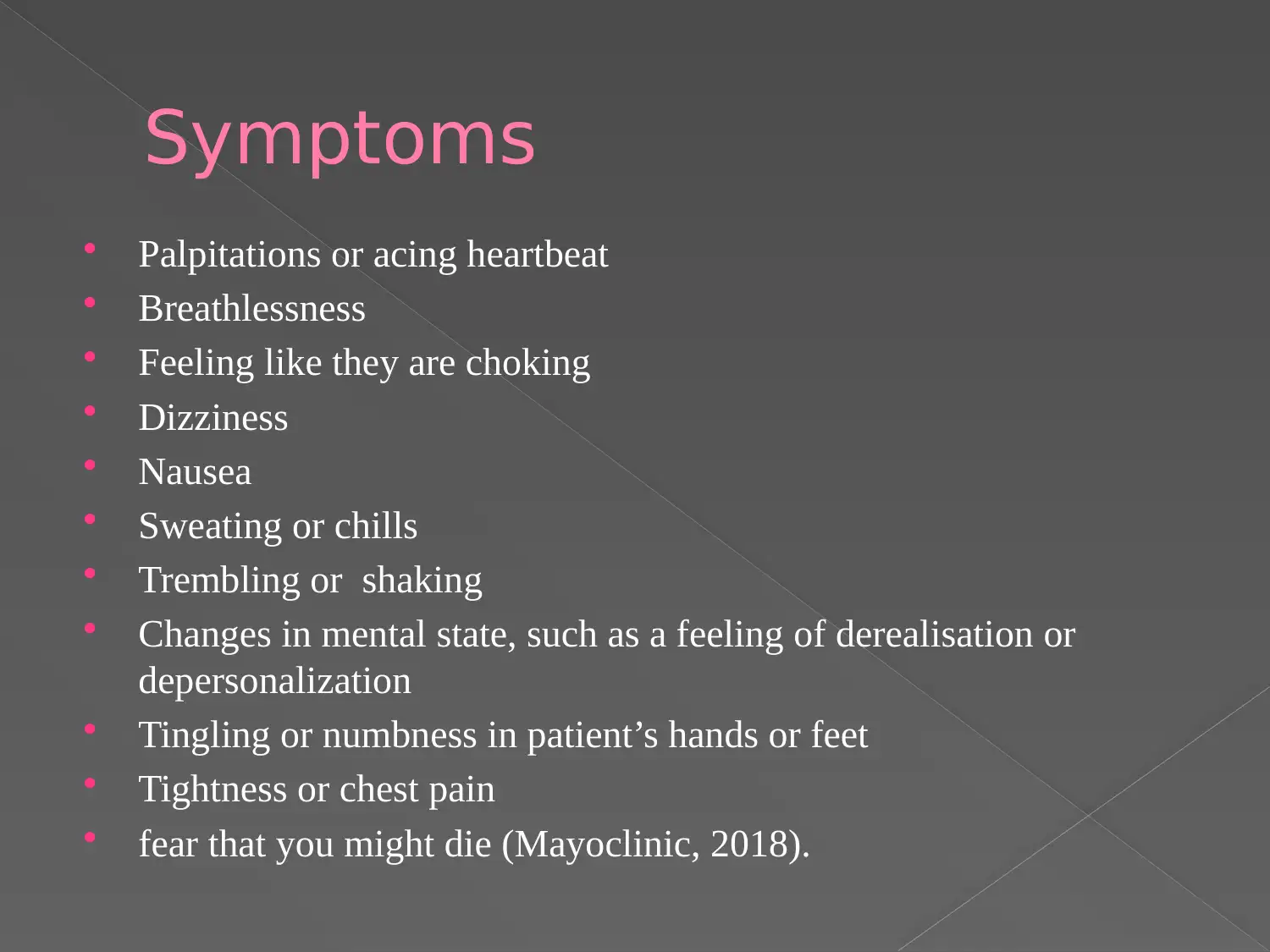
Symptoms
Palpitations or acing heartbeat
Breathlessness
Feeling like they are choking
Dizziness
Nausea
Sweating or chills
Trembling or shaking
Changes in mental state, such as a feeling of derealisation or
depersonalization
Tingling or numbness in patient’s hands or feet
Tightness or chest pain
fear that you might die (Mayoclinic, 2018).
Palpitations or acing heartbeat
Breathlessness
Feeling like they are choking
Dizziness
Nausea
Sweating or chills
Trembling or shaking
Changes in mental state, such as a feeling of derealisation or
depersonalization
Tingling or numbness in patient’s hands or feet
Tightness or chest pain
fear that you might die (Mayoclinic, 2018).
⊘ This is a preview!⊘
Do you want full access?
Subscribe today to unlock all pages.

Trusted by 1+ million students worldwide
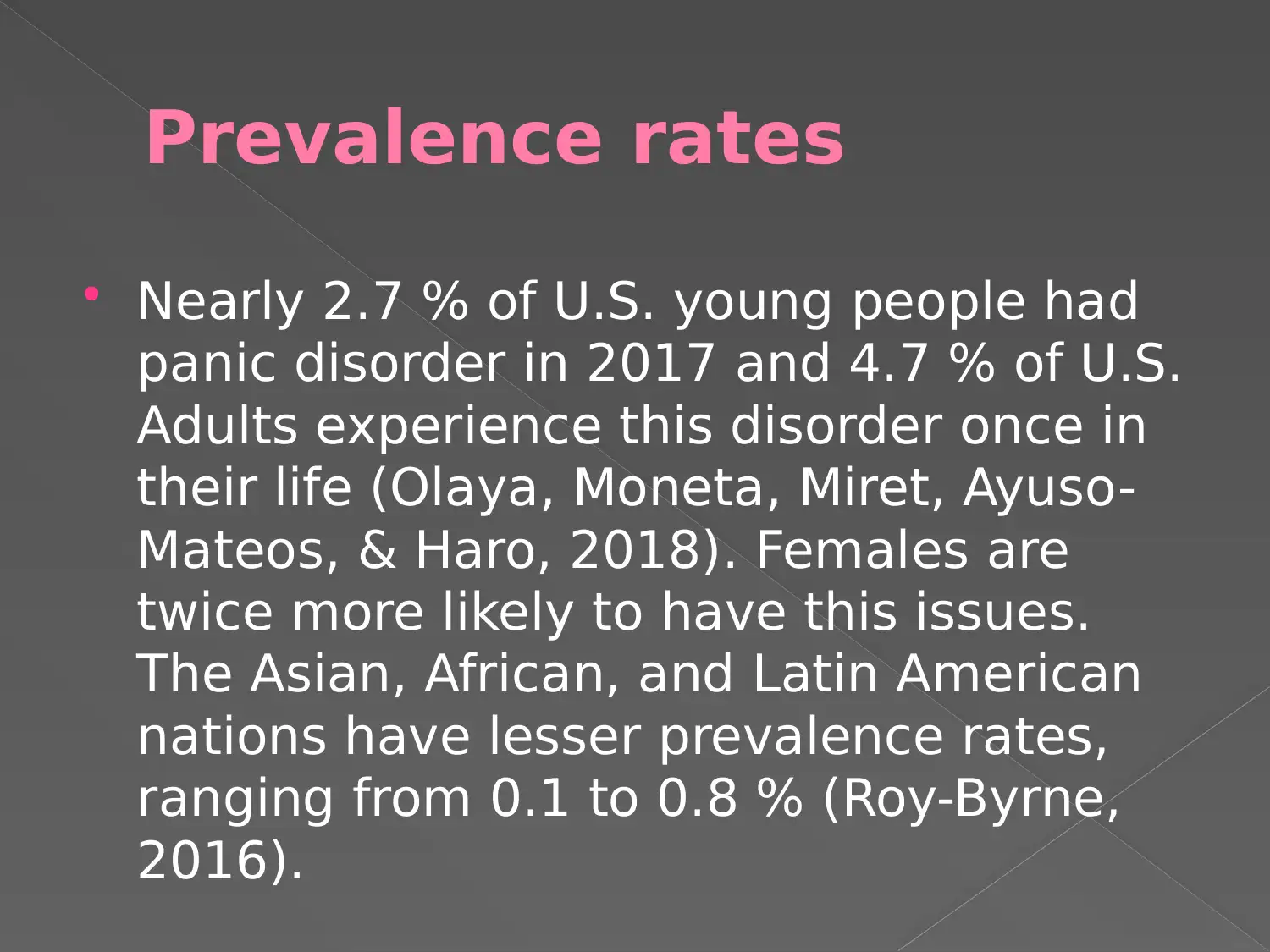
Prevalence rates
Nearly 2.7 % of U.S. young people had
panic disorder in 2017 and 4.7 % of U.S.
Adults experience this disorder once in
their life (Olaya, Moneta, Miret, Ayuso-
Mateos, & Haro, 2018). Females are
twice more likely to have this issues.
The Asian, African, and Latin American
nations have lesser prevalence rates,
ranging from 0.1 to 0.8 % (Roy-Byrne,
2016).
Nearly 2.7 % of U.S. young people had
panic disorder in 2017 and 4.7 % of U.S.
Adults experience this disorder once in
their life (Olaya, Moneta, Miret, Ayuso-
Mateos, & Haro, 2018). Females are
twice more likely to have this issues.
The Asian, African, and Latin American
nations have lesser prevalence rates,
ranging from 0.1 to 0.8 % (Roy-Byrne,
2016).
Paraphrase This Document
Need a fresh take? Get an instant paraphrase of this document with our AI Paraphraser
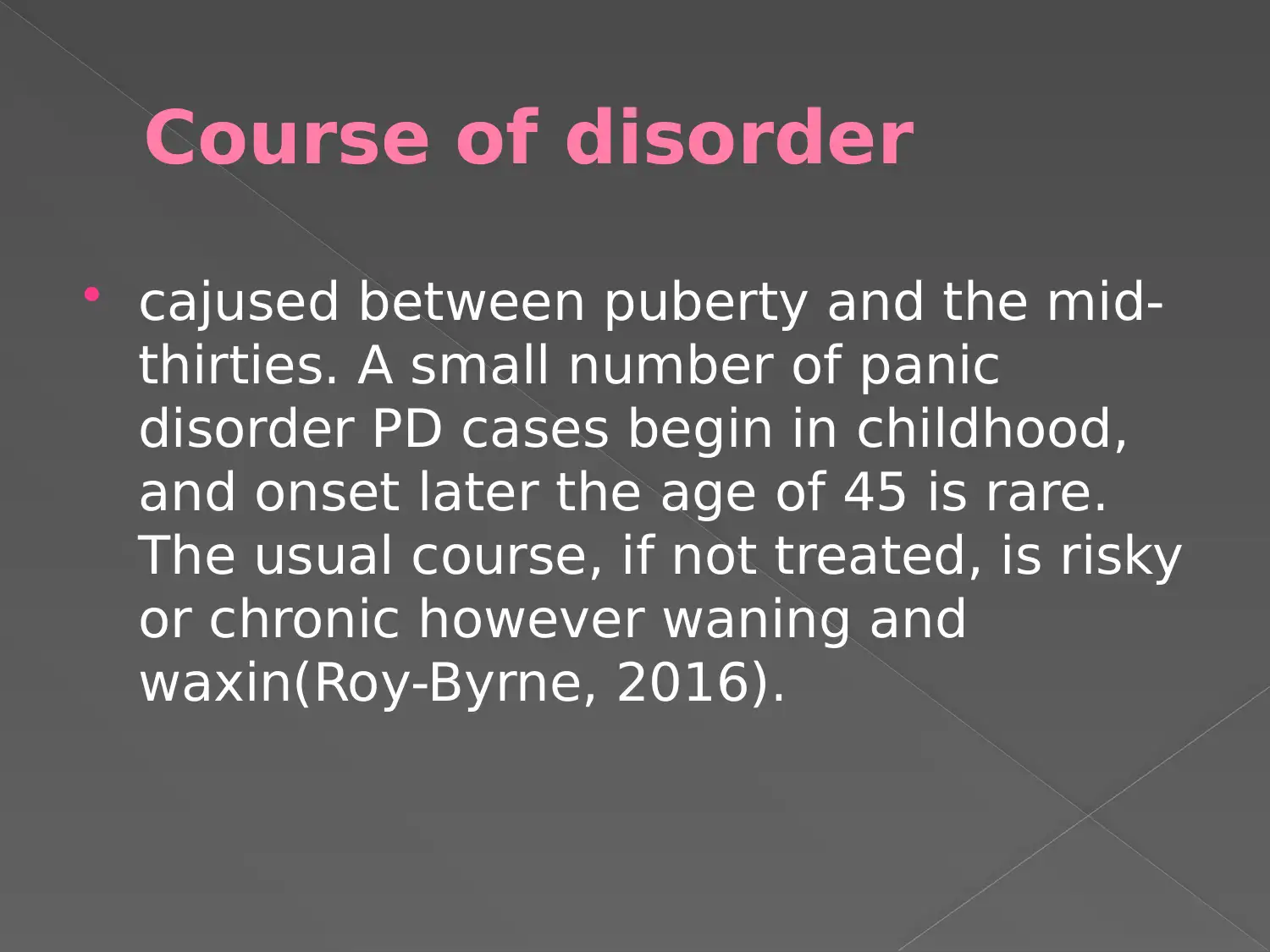
Course of disorder
cajused between puberty and the mid-
thirties. A small number of panic
disorder PD cases begin in childhood,
and onset later the age of 45 is rare.
The usual course, if not treated, is risky
or chronic however waning and
waxin(Roy-Byrne, 2016).
cajused between puberty and the mid-
thirties. A small number of panic
disorder PD cases begin in childhood,
and onset later the age of 45 is rare.
The usual course, if not treated, is risky
or chronic however waning and
waxin(Roy-Byrne, 2016).
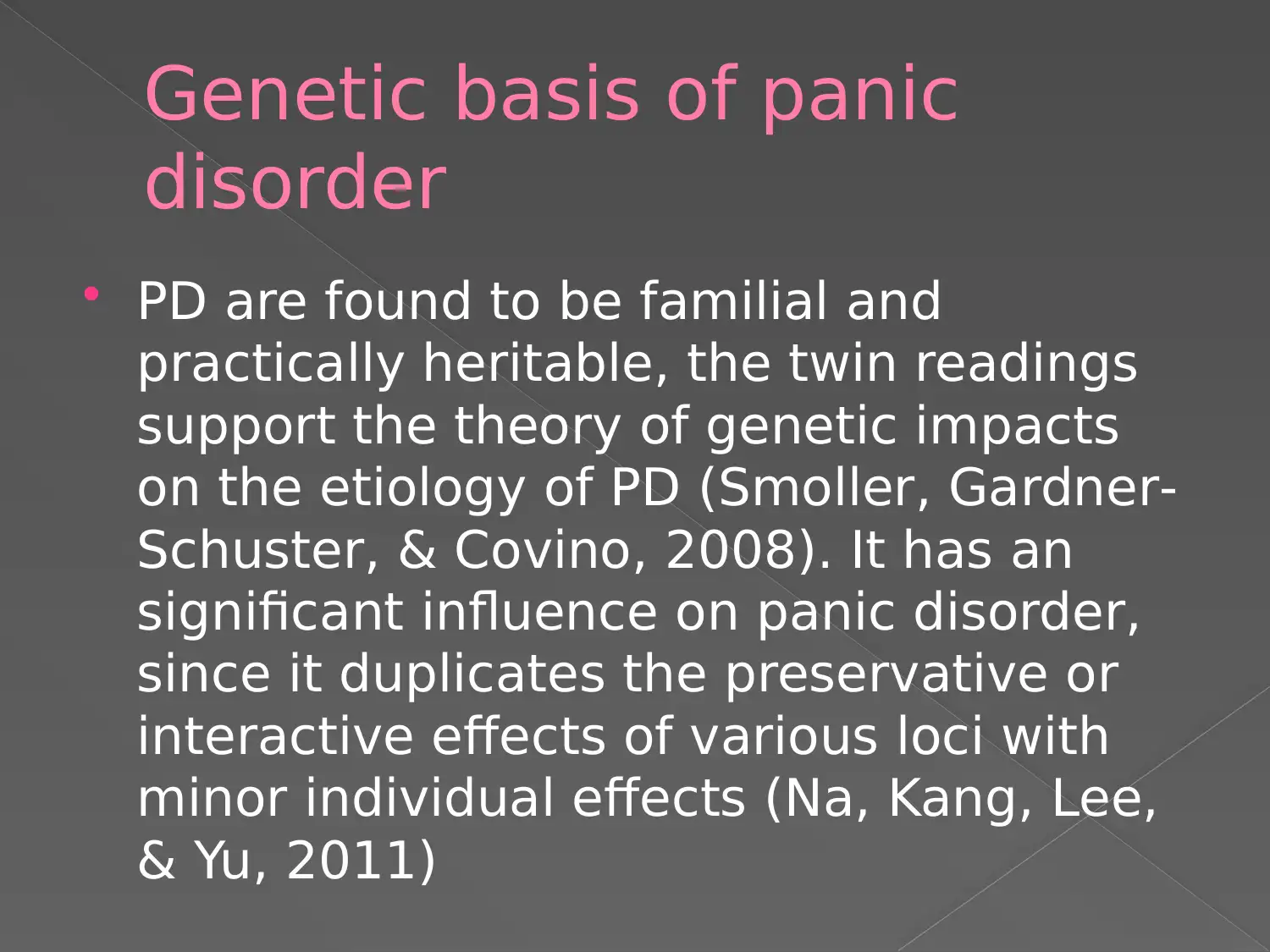
Genetic basis of panic
disorder
PD are found to be familial and
practically heritable, the twin readings
support the theory of genetic impacts
on the etiology of PD (Smoller, Gardner‐
Schuster, & Covino, 2008). It has an
significant influence on panic disorder,
since it duplicates the preservative or
interactive effects of various loci with
minor individual effects (Na, Kang, Lee,
& Yu, 2011)
disorder
PD are found to be familial and
practically heritable, the twin readings
support the theory of genetic impacts
on the etiology of PD (Smoller, Gardner‐
Schuster, & Covino, 2008). It has an
significant influence on panic disorder,
since it duplicates the preservative or
interactive effects of various loci with
minor individual effects (Na, Kang, Lee,
& Yu, 2011)
⊘ This is a preview!⊘
Do you want full access?
Subscribe today to unlock all pages.

Trusted by 1+ million students worldwide
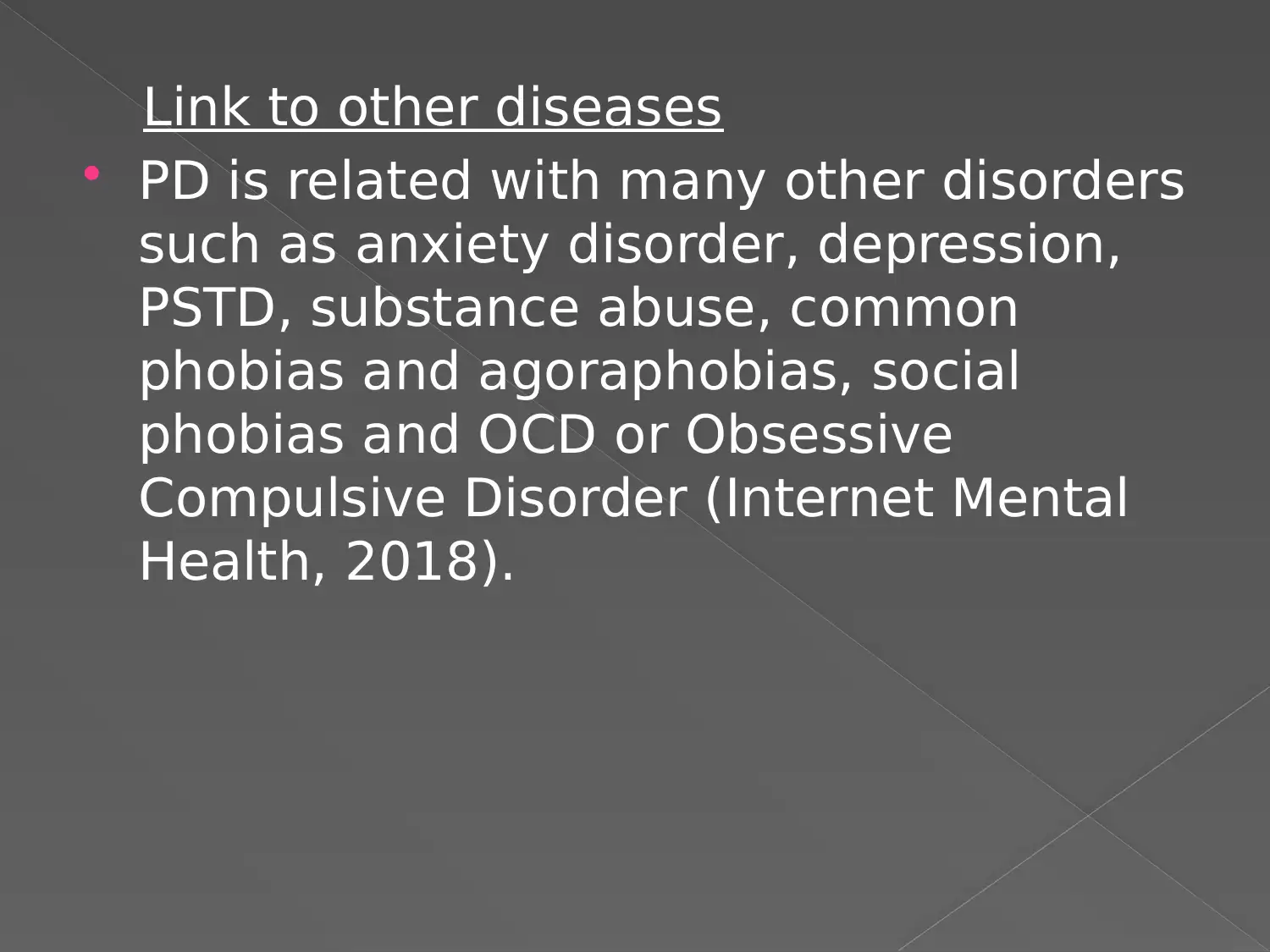
Link to other diseases
PD is related with many other disorders
such as anxiety disorder, depression,
PSTD, substance abuse, common
phobias and agoraphobias, social
phobias and OCD or Obsessive
Compulsive Disorder (Internet Mental
Health, 2018).
PD is related with many other disorders
such as anxiety disorder, depression,
PSTD, substance abuse, common
phobias and agoraphobias, social
phobias and OCD or Obsessive
Compulsive Disorder (Internet Mental
Health, 2018).
Paraphrase This Document
Need a fresh take? Get an instant paraphrase of this document with our AI Paraphraser
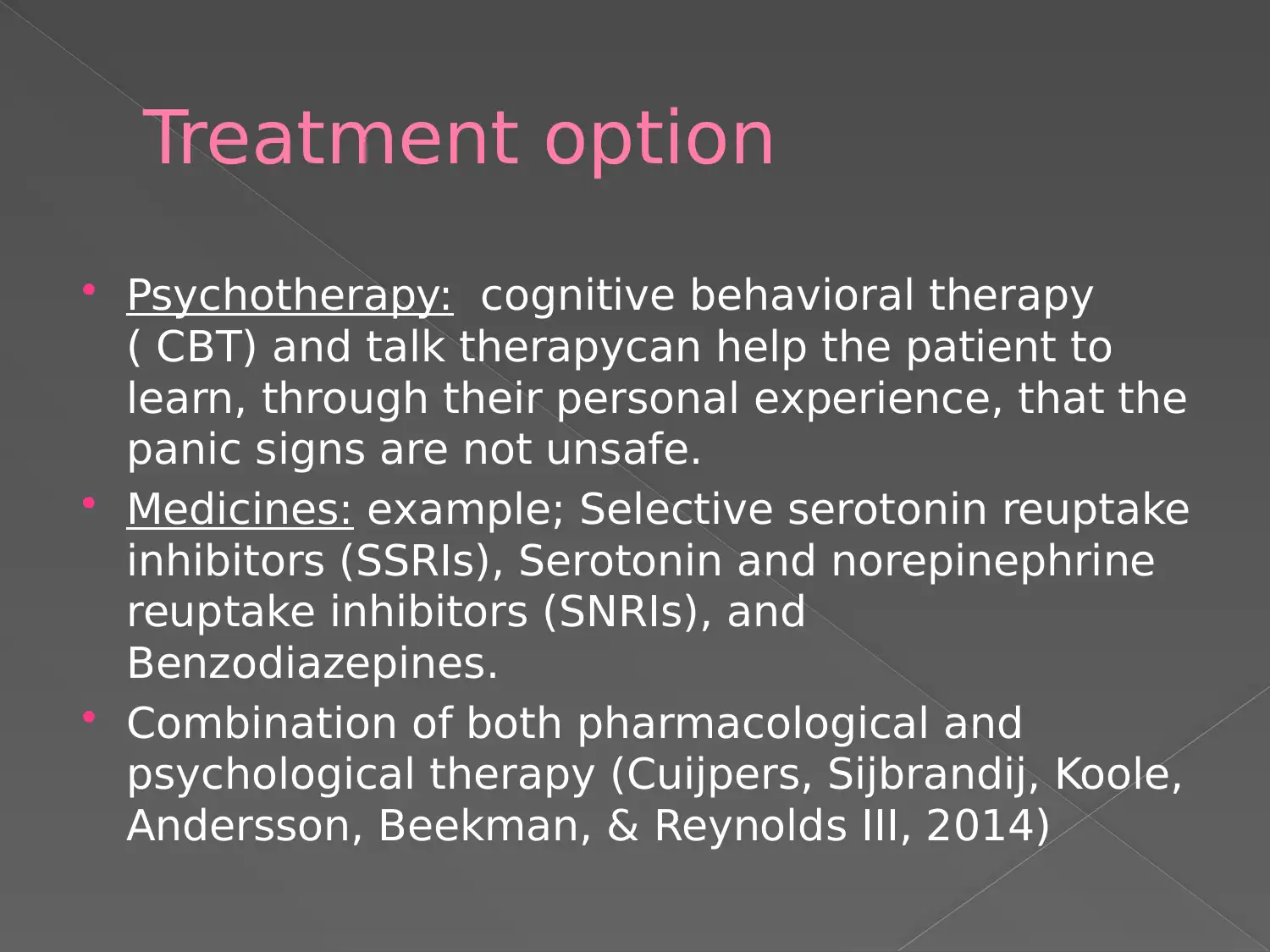
Treatment option
Psychotherapy: cognitive behavioral therapy
( CBT) and talk therapycan help the patient to
learn, through their personal experience, that the
panic signs are not unsafe.
Medicines: example; Selective serotonin reuptake
inhibitors (SSRIs), Serotonin and norepinephrine
reuptake inhibitors (SNRIs), and
Benzodiazepines.
Combination of both pharmacological and
psychological therapy (Cuijpers, Sijbrandij, Koole,
Andersson, Beekman, & Reynolds III, 2014)
Psychotherapy: cognitive behavioral therapy
( CBT) and talk therapycan help the patient to
learn, through their personal experience, that the
panic signs are not unsafe.
Medicines: example; Selective serotonin reuptake
inhibitors (SSRIs), Serotonin and norepinephrine
reuptake inhibitors (SNRIs), and
Benzodiazepines.
Combination of both pharmacological and
psychological therapy (Cuijpers, Sijbrandij, Koole,
Andersson, Beekman, & Reynolds III, 2014)

Current researches
MCTs, HCAR1s and breakdown of lactate must
be measured as potential markers when
emerging novel medications (Riske, Thomas,
Baker, & Dursun, 2017)
Panic patients may not have
sufficient opioid buffering; outcomes
heightened feeling to suffocation
and separation anxiety (Graeff, 2017).
Exercise have a favorable effect on
diminishing anxiety indications in PD patients
(Kemp, 2018).
MCTs, HCAR1s and breakdown of lactate must
be measured as potential markers when
emerging novel medications (Riske, Thomas,
Baker, & Dursun, 2017)
Panic patients may not have
sufficient opioid buffering; outcomes
heightened feeling to suffocation
and separation anxiety (Graeff, 2017).
Exercise have a favorable effect on
diminishing anxiety indications in PD patients
(Kemp, 2018).
⊘ This is a preview!⊘
Do you want full access?
Subscribe today to unlock all pages.

Trusted by 1+ million students worldwide
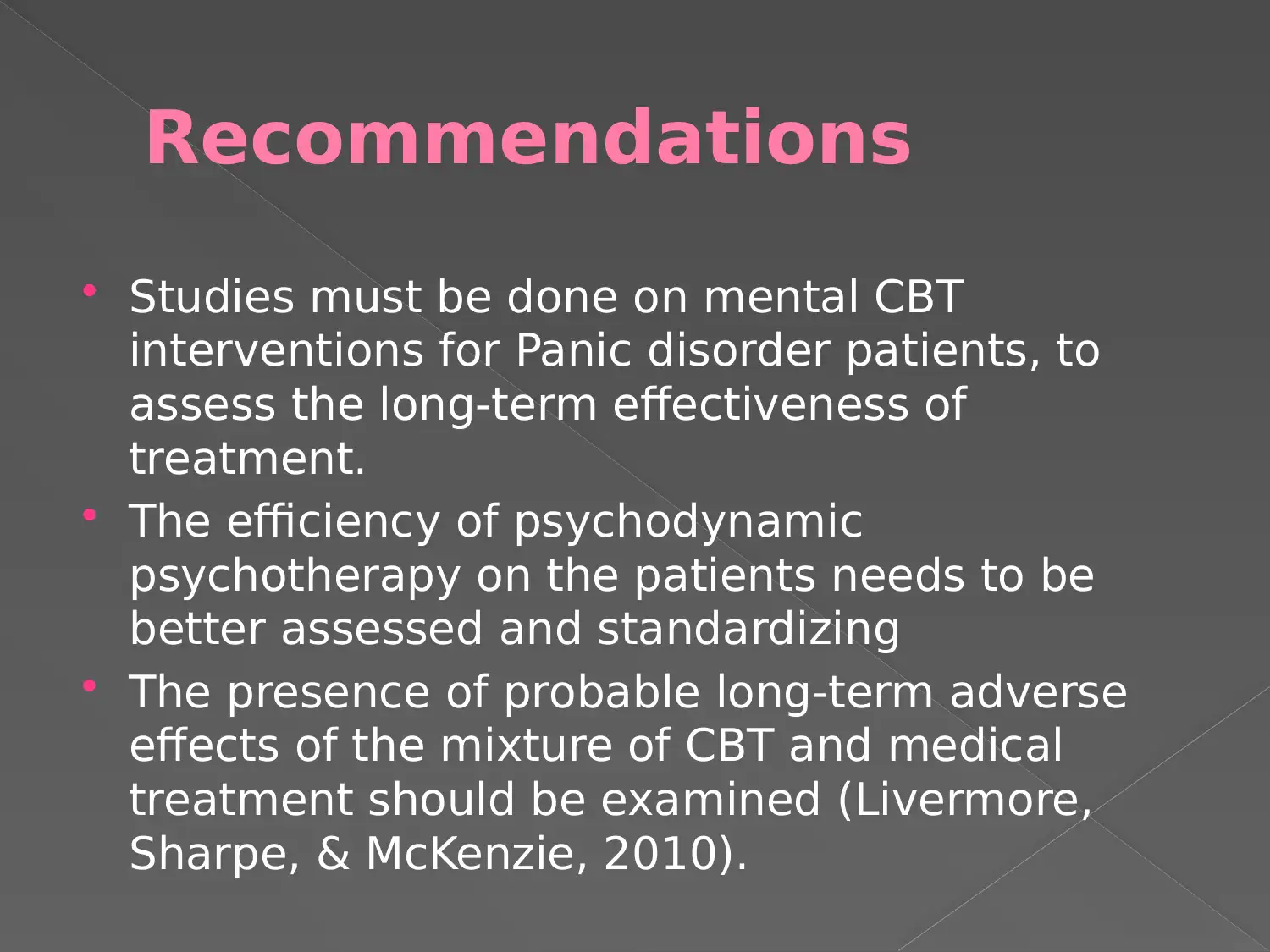
Recommendations
Studies must be done on mental CBT
interventions for Panic disorder patients, to
assess the long-term effectiveness of
treatment.
The efficiency of psychodynamic
psychotherapy on the patients needs to be
better assessed and standardizing
The presence of probable long-term adverse
effects of the mixture of CBT and medical
treatment should be examined (Livermore,
Sharpe, & McKenzie, 2010).
Studies must be done on mental CBT
interventions for Panic disorder patients, to
assess the long-term effectiveness of
treatment.
The efficiency of psychodynamic
psychotherapy on the patients needs to be
better assessed and standardizing
The presence of probable long-term adverse
effects of the mixture of CBT and medical
treatment should be examined (Livermore,
Sharpe, & McKenzie, 2010).
Paraphrase This Document
Need a fresh take? Get an instant paraphrase of this document with our AI Paraphraser
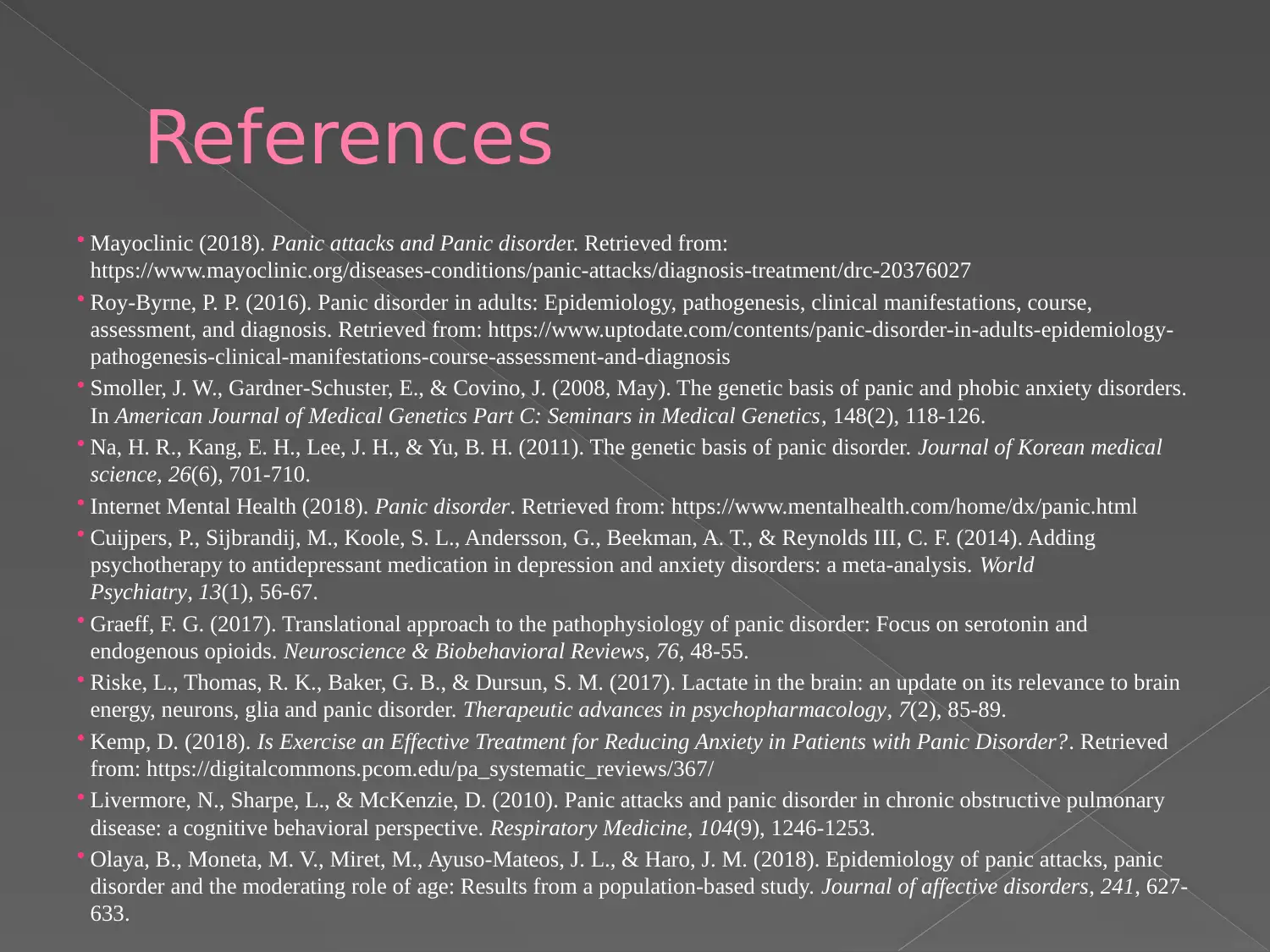
References
Mayoclinic (2018). Panic attacks and Panic disorder. Retrieved from:
https://www.mayoclinic.org/diseases-conditions/panic-attacks/diagnosis-treatment/drc-20376027
Roy-Byrne, P. P. (2016). Panic disorder in adults: Epidemiology, pathogenesis, clinical manifestations, course,
assessment, and diagnosis. Retrieved from: https://www.uptodate.com/contents/panic-disorder-in-adults-epidemiology-
pathogenesis-clinical-manifestations-course-assessment-and-diagnosis
Smoller, J. W., Gardner‐Schuster, E., & Covino, J. (2008, May). The genetic basis of panic and phobic anxiety disorders.
In American Journal of Medical Genetics Part C: Seminars in Medical Genetics, 148(2), 118-126.
Na, H. R., Kang, E. H., Lee, J. H., & Yu, B. H. (2011). The genetic basis of panic disorder. Journal of Korean medical
science, 26(6), 701-710.
Internet Mental Health (2018). Panic disorder. Retrieved from: https://www.mentalhealth.com/home/dx/panic.html
Cuijpers, P., Sijbrandij, M., Koole, S. L., Andersson, G., Beekman, A. T., & Reynolds III, C. F. (2014). Adding
psychotherapy to antidepressant medication in depression and anxiety disorders: a meta‐analysis. World
Psychiatry, 13(1), 56-67.
Graeff, F. G. (2017). Translational approach to the pathophysiology of panic disorder: Focus on serotonin and
endogenous opioids. Neuroscience & Biobehavioral Reviews, 76, 48-55.
Riske, L., Thomas, R. K., Baker, G. B., & Dursun, S. M. (2017). Lactate in the brain: an update on its relevance to brain
energy, neurons, glia and panic disorder. Therapeutic advances in psychopharmacology, 7(2), 85-89.
Kemp, D. (2018). Is Exercise an Effective Treatment for Reducing Anxiety in Patients with Panic Disorder?. Retrieved
from: https://digitalcommons.pcom.edu/pa_systematic_reviews/367/
Livermore, N., Sharpe, L., & McKenzie, D. (2010). Panic attacks and panic disorder in chronic obstructive pulmonary
disease: a cognitive behavioral perspective. Respiratory Medicine, 104(9), 1246-1253.
Olaya, B., Moneta, M. V., Miret, M., Ayuso-Mateos, J. L., & Haro, J. M. (2018). Epidemiology of panic attacks, panic
disorder and the moderating role of age: Results from a population-based study. Journal of affective disorders, 241, 627-
633.
Mayoclinic (2018). Panic attacks and Panic disorder. Retrieved from:
https://www.mayoclinic.org/diseases-conditions/panic-attacks/diagnosis-treatment/drc-20376027
Roy-Byrne, P. P. (2016). Panic disorder in adults: Epidemiology, pathogenesis, clinical manifestations, course,
assessment, and diagnosis. Retrieved from: https://www.uptodate.com/contents/panic-disorder-in-adults-epidemiology-
pathogenesis-clinical-manifestations-course-assessment-and-diagnosis
Smoller, J. W., Gardner‐Schuster, E., & Covino, J. (2008, May). The genetic basis of panic and phobic anxiety disorders.
In American Journal of Medical Genetics Part C: Seminars in Medical Genetics, 148(2), 118-126.
Na, H. R., Kang, E. H., Lee, J. H., & Yu, B. H. (2011). The genetic basis of panic disorder. Journal of Korean medical
science, 26(6), 701-710.
Internet Mental Health (2018). Panic disorder. Retrieved from: https://www.mentalhealth.com/home/dx/panic.html
Cuijpers, P., Sijbrandij, M., Koole, S. L., Andersson, G., Beekman, A. T., & Reynolds III, C. F. (2014). Adding
psychotherapy to antidepressant medication in depression and anxiety disorders: a meta‐analysis. World
Psychiatry, 13(1), 56-67.
Graeff, F. G. (2017). Translational approach to the pathophysiology of panic disorder: Focus on serotonin and
endogenous opioids. Neuroscience & Biobehavioral Reviews, 76, 48-55.
Riske, L., Thomas, R. K., Baker, G. B., & Dursun, S. M. (2017). Lactate in the brain: an update on its relevance to brain
energy, neurons, glia and panic disorder. Therapeutic advances in psychopharmacology, 7(2), 85-89.
Kemp, D. (2018). Is Exercise an Effective Treatment for Reducing Anxiety in Patients with Panic Disorder?. Retrieved
from: https://digitalcommons.pcom.edu/pa_systematic_reviews/367/
Livermore, N., Sharpe, L., & McKenzie, D. (2010). Panic attacks and panic disorder in chronic obstructive pulmonary
disease: a cognitive behavioral perspective. Respiratory Medicine, 104(9), 1246-1253.
Olaya, B., Moneta, M. V., Miret, M., Ayuso-Mateos, J. L., & Haro, J. M. (2018). Epidemiology of panic attacks, panic
disorder and the moderating role of age: Results from a population-based study. Journal of affective disorders, 241, 627-
633.
1 out of 11
Related Documents
Your All-in-One AI-Powered Toolkit for Academic Success.
+13062052269
info@desklib.com
Available 24*7 on WhatsApp / Email
![[object Object]](/_next/static/media/star-bottom.7253800d.svg)
Unlock your academic potential
Copyright © 2020–2025 A2Z Services. All Rights Reserved. Developed and managed by ZUCOL.




